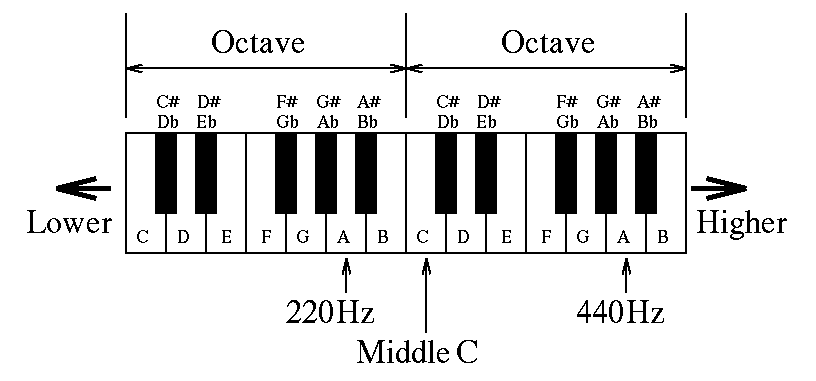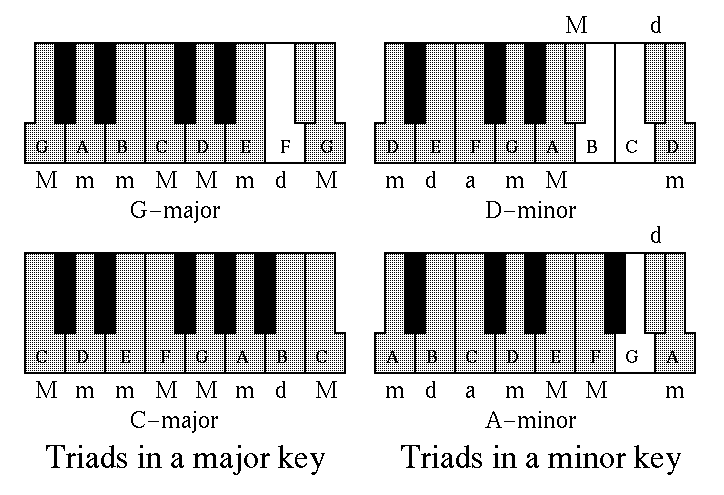This chapter is here to explain the basics of the western system of music. It's aim is to present the non-musical reader with some of the musical terminology that will be present in the rest of this report. I assume that the reader has no knowledge of music and therefore the musically competent reader is advised to advance to the next chapter.
A note is the basic unit of music and relates to the pitch or frequency of a sound. Some musical instruments are monophonic and can only play one note at once, like a flute or a human voice, and others are polyphonic. Both the guitar and the piano, for instance, and can play multiple notes simultaneously.
Notes can be played at different pitches, and the difference between the pitches of two notes is usually referred to as an interval.
The most basic interval of music the octave.This interval relates to a doubling or halving of the frequency of a note. You can hear this difference in pitch when you hear a male vocalist and a female vocalist singing the same tune.
New notes can be defined in relation to the octave by splitting this interval into a number of smaller ones. Different cultures around the world use different numbers of intervals and it is primarily this, and the way in which the intervals are used rhythmically, that uniquely defines the culture's sound.
Western music has evolved into a system that partitions the octave into twelve equal intervals called semi-tones. Each of the notes created by doing this are labelled using the letters A though to G, and the modifiers '#' (sharp), which means 'add one semi-tone', and 'b' (flat), which means 'subtract one semi-tone'. The layout of the piano keyboard below shows how this system works.

The normal frequency of the A above Middle-C on the keyboard is 440Hz, and it is this note that instruments are usually tuned to. An instrument tuned to this frequency is said to be tuned to concert pitch. The reason for starting at the key marked C is historical.
Each key is a semi-tone above the key below it. So D is a tone (two semi-tones) above C, E is a tone above D, and F is a semi-tone above E. The black note above C is called by two names: C# or Db, and as can be seen from the diagram all the black notes have two names. Around the time of Bach's "Well-Tempered Clavier" (1722-44) it was decided that all semi-tones would be at equal intervals. Previous to this time C# and Db weren't the same note as we shall see later.
It gets some what more complicated than this as music theory also allows for a double sharp (## or x) and a double flat (bb) which add or subtract two semi-tones from a note. In the equally tempered system this gives each note potentially three different names. A 'C' could be one of C, B#, or Dbb. Notes referred to by more than one name are usually called Enharmonic.
A scale is any consecutive series of notes that forms a progression between one note and its octave. The scale can go either up by an octave or down by an octave. The word comes from the Latin scala, meaning ladder, and this is exactly what a scale is - a way of ascending or descending an octave, with each rung representing one of the notes in between.
There are many different types of scale but the most important ones in Western music are the diatonic major scale and the three relative minor scales.
If you refer to the piano keyboard above and only consider the white notes then starting at C we have: C, D, E, F, G, A, B, C. This is the major scale with a root note of C, or C major for short. The major scale has its own distinct pattern of tones and semi-tones, for instance there is a gap of a tone between the C and the D, but only a semi-tone interval between E and F. Any combination of notes that maintains this set of interval relationships is a major scale. The scale of F# major would have the notes: F#, G#, A#, B, C#, D#, E#, F#. The notes names always go up one letter at a time and accidentals (#s or bs) are added to maintain the interval sequence. You could also theoretically have a Gb major as well even though F# and Gb are the same note. It's notes would be Gb, Ab, Bb, Cb, Db, Eb, F, Gb.
There are three types of minor scale. The first one is called the natural minor and has exactly the same combination of tones and semi-tones that the major has, except that it starts from the major's sixth note. For example, the scale of 'A' minor has the notes A, B, C, D, E, F, G, A. This is like shifting the scale of C major by six notes. A minor is therefore called the relative minor of C major because it has the same number of accidentals as the major (in this case none).

The harmonic and melodic minors share the same semi-tone interval between the 2nd and 3rd degrees of the scale, but have modified intervals on the higher degrees of the scale. The harmonic minor has a raised 7th (by one semi-tone) which makes it more compatible with the harmony rules used by the major scale. On the other hand the melodic minor, which is used for melodies, was constructed to avoid the three semi-tone interval, which was considered an unacceptably large jump when used in a melody, by raising the 7th and 6th degrees of the scale (as in the diagram) on the way up, and then lowering them, as in the natural minor scale, on the way down.
The number of sharps or flats in the major or natural minor uniquely defines a scale. For instance A major has three sharps (F#, C# and G#) and is the only major scale to have so. It's relative minor, F# minor, also has three sharps in its natural minor form. This pattern follows thoughout. The major scale and its relative minor always share the same number of sharps or flats, and these are unique to those scales. This combination of sharps or flats is called a key signature.
Any two notes played together describe an interval. Three or more notes played together are called a chord.
A triad is a simultaneous combination of three notes. It can be made up of any note plus the the two notes a third and a fifth above it. The means that a triad has two intervals, each of a third. All triads are three note chords, but not all three note chords are triads. In the harmonic series of any note, the tonic is the fundamental, and the octave, the 5th and the 3rd are the most prominent overtones. These are the notes that make up the triad, and the reinforcement of these overtones gives it its strong sound.
The four types of triad are: the major triad (C, E, G), the minor triad (C, Eb, G), the augmented triad (C, E, G#), and the diminished triad (C, Eb, Gb).

A triad can be built starting on any of the notes of either the major or minor scales. This gives chords that are associated with the key and it is the overlap of these chords between keys that allows harmonic movement within chord progressions.

In the above diagram the triads for a major and a harmonic minor scale are shown. For the example of the C-major scale it can be seen that the following triads exist: C-major, D-minor, E-minor, F-major, G-major, A-minor and B-diminished, and in D-minor: D-minor, E-diminished, F-augmented, G-minor, A-major, Bb-major and C#-diminished. The triads of a minor key therefore are different from those of a major scale.
Some keys are closely related to each other. Consider the triads in the G-major and C-major keys. If you refer to the above diagram you can see that four out of the seven triads are identical: G-major, A-minor, C-major and E-minor. This means that it is fairly easy to change the key centre from C-major into G-major by using the shared chords as harmonic pivets to change the key. This process is called modulation. The same follows for F-major and C-major. The F is the fourth degree, or sub-dominant, of C and the G is the fifth degree, or dominant, of C. Triads built on these degrees of the scale will always sound good when played in progression with the root triad, and majority of music is based upon this premise.
There are far more complex chords than triads, but the triads tend to account for most of musical harmony with other chords adding additional spice. Seventh chords which add another third interval on top of an existing triad are used to make a chord sound more interesting and have become a feature of both Blues and Jazz, where 11th and 13th chords are often used as well.
As music is an event that concerns both notes and time this section would not be complete without a brief mention of rhythm.
The basic unit of time is called the beat. Beats are usually grouped into threes or fours depending upon the time signature of the piece. For example waltzes are always in three time, and marches in four. These groupings of beats are called bars or measures and are important focuses for the harmony.
Musical phrases are usually multiples of two bars with the harmony starting at a particular key, possibly modulating to other intermediate keys during the phrase, and then usually returning to the start key near the end.
The term tempo describes the rate of the beats and is usually in the order of between sixty and two hundred beats per minute. At sixty beats per minute a bar would pass every four seconds. Rhythm is the way in which a tempo is played and dictates how the notes are emphasised, or "accented". It is this aspect that produces the "feel" of the music.
The beat can be split into smaller intervals of time, which can be combined to produce any note length. These all have names, for instance a single beat is called a crochet and a half-beat called a quaver. They can also be described as fractions of a four beat bar, the crochet becoming known as a quarter note, the quaver as an eighth note, and so on.